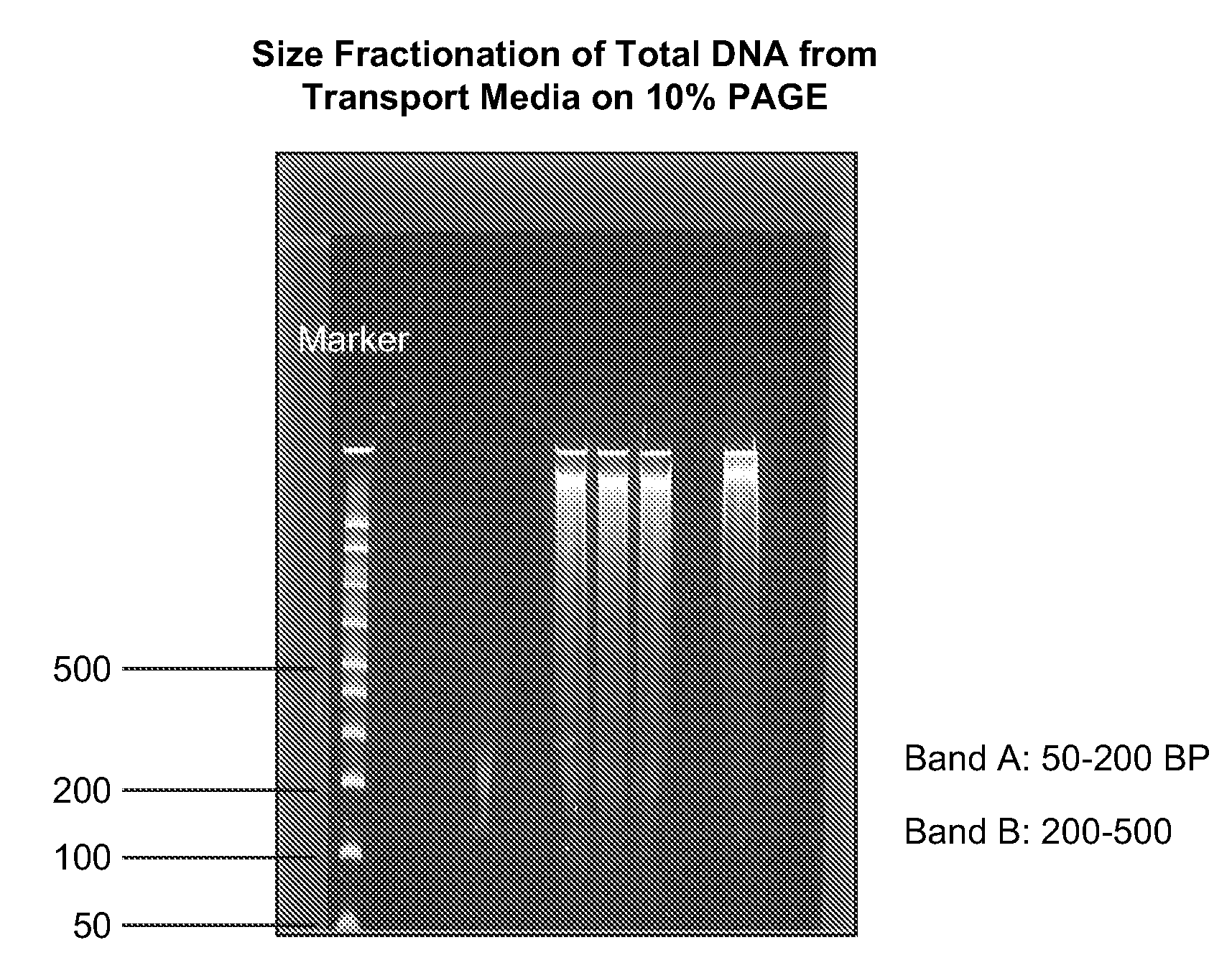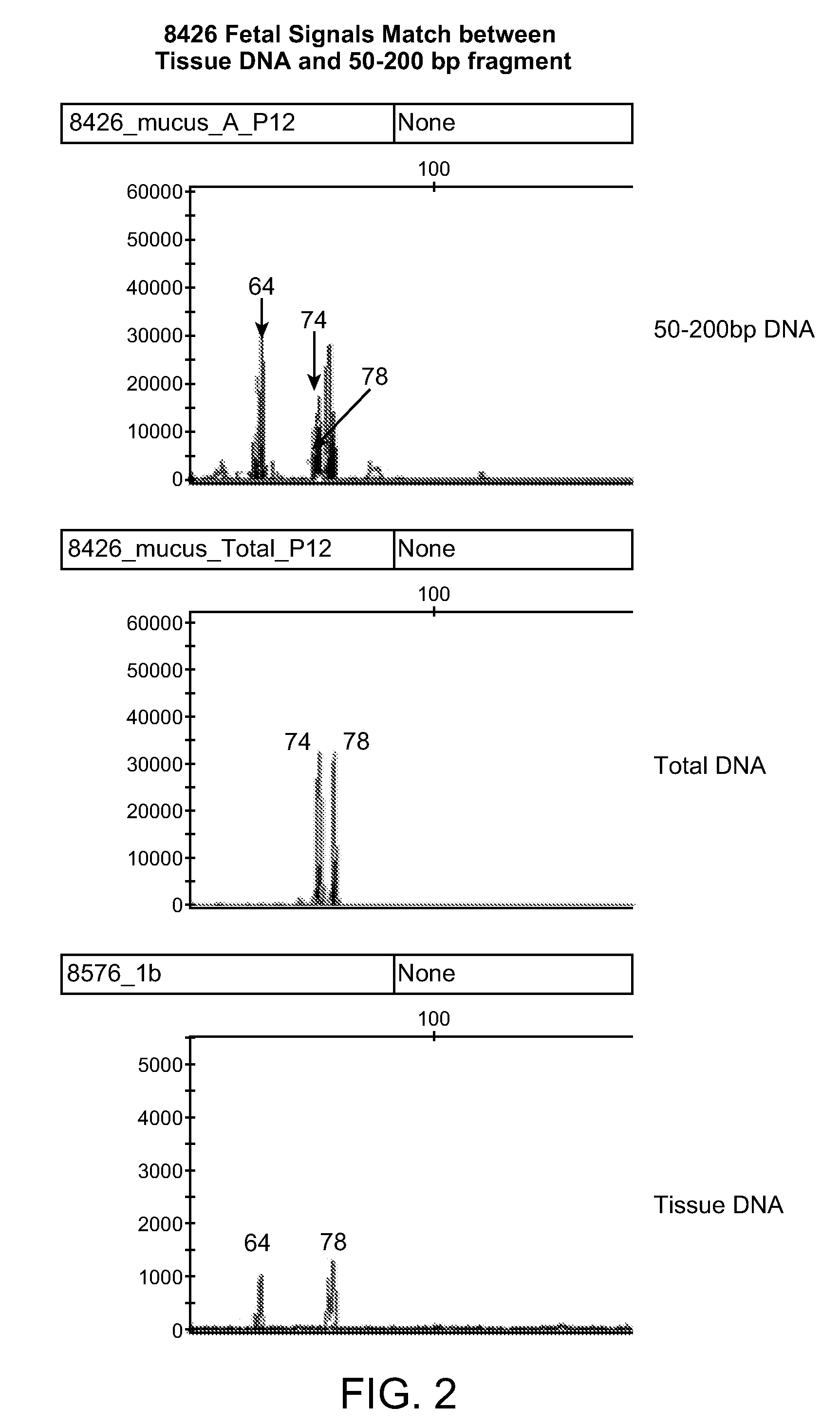Non-invasive prenatal genetic screen
a prenatal genetic and non-invasive technology, applied in the direction of microbiological testing/measurement, biochemistry apparatus and processes, etc., can solve the problems of 80% of down syndrome babies born, the risk of miscarriage,
- Summary
- Abstract
- Description
- Claims
- Application Information
AI Technical Summary
Benefits of technology
Problems solved by technology
Method used
Image
Examples
example 1
[0039]This Example describes the collection and isolation of fetal DNA from pregnant women.
[0040]Cervical mucous samples were collected from patients, after due consent, by cytobrush method. In the cytobrush method, a Pap smear cytobrush (e.g. MedScand-AB, Malmo, Sweden) was inserted to a maximum depth of 2 cm and removed while rotating it a full turn (i.e., 360°). In order to remove the transcervical cells caught on the brush, the brush was shaken into a test tube containing 2-3 ml of a tissue culture medium (e.g., RPMI-1640 medium, available ATCC, Virginia) in the presence of 1% Penicillin Streptomycin antibiotic. In order to concentrate the transcervical cells on microscopic slides cytospin slides were prepared using e.g. a Cytofunnel Chamber Cytocentrifuge (Thermo-Shandon, England). The conditions used for cytocentrifugation are dependent on the murkiness of the transcervical specimen; if the specimen contained only a few cells, the cells are first centrifuged for five minutes a...
example 2
[0042]This Example demonstrates that the DNA obtained from the cervical mucous samples after PAGE purification is indeed fetal DNA.
[0043]The total DNA obtained from the cervical swap was size fractionated on 10% PAGE, and the small, 50-250 base pair DNA band (see FIG. 1) was sliced out. The DNA was extracted from PAGE using Promega's Membrane Binding buffer, and its concentration was determined by NanoDrop-1000 Spectrophotometer.
[0044]10-20 ng of this size-fractionated DNA was amplified by PCR with primers designed to amplify short STR regions (e.g., D22S1045, CSF1P0, D2S441 see Table 1 for detail).
Typical PCR reaction components were:10 mM dNTP2.0 μl25 mM MgCl21.5 μl50 mM Primers0.5 μlTemplate 1 μg / μl2.0 μlAmpli Taq Gold0.5 μl10X PCR Buffer2.5 μlWater16.0 μl
[0045]Typical PCR cycle consisted of: Denaturation temperature of 94° C. for 30 sec, annealing temperature varied from 56 to 62° C. depending upon the primer length, extension was done at 72° C. Number of cycles used ranged fro...
example 3
[0047]This Example demonstrates that the mini-STR markers detect fetal alleles.
[0048]Mini-STR markers of the invention were used to detect fetal alleles from DNA extracted from clinical cervical mucous samples. Table 1, below, summarizes the results obtained. D1S1677-F and -R, D22S1045-F and -R, DIOS1248-F and -R, TPOX, Mini-LFG33-F and -R, and Mini-LFG34-F and -R are exemplary primers of the invention.
TABLE 1Detection of Fetal Allele from Clinical Cervical Mucus SamplesPCR AnalysisPresenceSampleSampleGelInformativeMaternalFetalof FetalIDTypeEnrichedPrimer SetSequenceSeq. ID No.AllelesAlleleAllele7601Transport8% PAGED1S1677-FFAM-TTCTGTTGGTATAGASEQ ID NO: 190.21, 94.9199.91YesMediaGCAGTGTTTD1S1677-RGTGACAGGAAGGACGAATGSEQ ID NO: 27602TransportD22S1045-FFAM-ATTTTCCCCGATGATASEQ ID NO: 395.11, 97.8185.61YesMediaGTAGTCTD22S1045-RGCGAATGTATGATTGGCAATSEQ ID NO: 4ATTTTT7604TransportD22S1045-FFAM-ATTTTCCCCGATGATASEQ ID NO: 398.1592.44YesMediaGTAGTCTD22S1045-RGCGAATGTATGATTGGCAATSEQ ID NO: 410...
PUM
 Login to View More
Login to View More Abstract
Description
Claims
Application Information
 Login to View More
Login to View More - R&D
- Intellectual Property
- Life Sciences
- Materials
- Tech Scout
- Unparalleled Data Quality
- Higher Quality Content
- 60% Fewer Hallucinations
Browse by: Latest US Patents, China's latest patents, Technical Efficacy Thesaurus, Application Domain, Technology Topic, Popular Technical Reports.
© 2025 PatSnap. All rights reserved.Legal|Privacy policy|Modern Slavery Act Transparency Statement|Sitemap|About US| Contact US: help@patsnap.com



